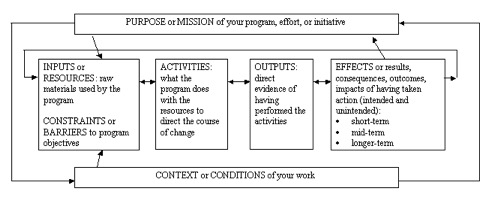A Special Kind of Roadmap
As previously discussed in my wayfinding series the term ‘wayfinding’ historically refers to the techniques used by ancient peoples of Polynesia to explore the islands of the Pacific.
More recently, the term has been applied to helping people navigate their communities, and fits neatly with the concept of human-centered mobility which places the user directly at the heart of design. ‘Wayfinding’ provides a useful metaphor for thinking about evaluation and performance measurement– and as a journey of dedication, discovery, and strategy. For any journey, a ‘roadmap’ and compass are essential.
The ‘logic model’ is a special kind of compass and roadmap that show, in a visual display, the relationships among the resources, activities, and outcomes for your program. The value of a logic model is that it presents the elements of a program’s work and visually expresses beliefs about why the program is likely to succeed. It shows the relationship between your program’s activities and its intended effects – in other words, if I do this activity, then I expect this outcome. A logic model helps define the boundary between ‘what’ the program is doing and the question — ‘so, what are the results of all the things we are doing?
A theory of change, or logic model, is the foundation for what an organization does and why it does it. It should answer:
- What impact do you hope to achieve?
- What is the mechanism by which you achieve that impact?
- How will you know when you’ve achieved it?
A strong theory of change requires that programs think through how their activities intend to achieve impact – the ‘active ingredients’ that effect change and outcomes for your target customers or clients.
The logic of programs has another meaning that lies closer to heart of community change: the logic of how things work. Logic in this sense refers to the relationships among elements and seeing patterns in complex phenomena that occur in programs. Logic models are useful for both new and existing programs and initiatives. If your effort is in the planning stage, then a logic model can help get it off to a good start. If your program is already under way, a model can help you describe, modify or enhance it.
Building a Logic Model
The logic model is known by many names, including program roadmaps, theory of change, theory of action, blueprint for change, and outcome maps. Regardless of the name, they all rest on a foundation of logic – specifically, the logic of how change happens. Here are some key terms and concepts that are common elements in all logic models:
- Inputs: The resources needed to implement the program’s activities (e.g., funding, staff, collaborators, space).
- Activities: What the program and its staff actually do with those resources (e.g., hire drivers, provide training, outreach to partners to collaborate).
- Outputs: Tangible products, capacities, or deliverables that result from the activities (e.g., numbers of customers enrolled, numbers of rides, number of incentives provided, drivers hired, new case managers hired, vans on the road, training sessions provided, and partners engaged).
- Outcomes: Changes that occur in other people or programs or community conditions because of the activities and outputs (e.g., increased ridership, decrease in no-shows to health appointments, positive customer feedback on quality of services, establishment of cooperative agreements that support interagency collaboration).
- Impacts: The broader, long-term outcomes over time (improved client health, reduction in re-hospitalizations, increased availability of transportation options in the community, increased ridership among persons with disabilities, reduced ride times, increased funding for sustaining services).
- Moderators: Contextual factors that are out of control of the program but may help or hinder achievement of the outcomes (CDC Program Evaluation Framework).
Putting these elements together graphically gives the following basic structure for a logic model. The arrows between the boxes indicate that review and adjustment are an ongoing process – both in enacting the initiative and developing the model.


